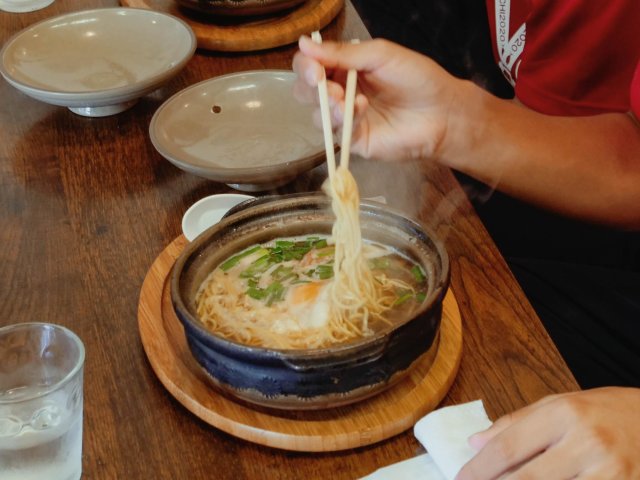I’m Etto the Best Zuckemen!
This minimalist, light wooden affair is a Zen as soon as the Ramen shop ร้านราเมง
appears. It specializes in seafood and chicken broth, which is smoother and less oily than the ubiquitous version of fincottzu, although Noko Gyokai ramen should soothe even the most persistent pork bone fan. There are also two sizes of freshly prepared noodles and an incredibly gentle trio of meat soups (chicken, pork belly and pork shoulder blade).
Kyushu Djangara Ramen Ramen.
Returning to Japan, this place boasts wildly popular branches, with almost permanent queues of snakes on the street. Here in Bangkok, you’ll find a different horde of people, but you’ll find a delicious and daring taste in the Zenburi frame, which comes with large pieces of stewed pork, boiled eggs and a piece of salted, pickled cod roe.
Bankara Ramen Best Tonkotsu!
Promising only a good cholesterol attack, this dull Ramen house puts its name on a thick broth of thinnest noodles, perfect al dente noodles and a sinful slowly cooked bowl. Each menu page lists hot steam bowls (plus karaage, rice bowls and other Japanese hits), but we’ll save you time: order a can of Kakuni Bankara for a three-day pork abdomen that really melts in your mouth.
Yippudo Ramen.
Three-time champion chef Shigemi Kawahara from Fukuoka came to Bangkok in great style with the launch of the Ippudo game at the Central Embassy in 2013, and since then has expanded its activities throughout the city. The restaurant’s original location includes three fine-tuning ramen styles created by Chef Shigemi in the style of a hackata, in a magnificent setting of kanji calligraphic screens and black and red décor – a shop of higher class clothing than the Ramen country show.
I’m Kouji.
This creamy, earthy ramen comes from Sanuki Prefecture in Ibaraki and comes to Bangkok as a courtesy of a chef with vacancies in the United States, Canada, the Philippines and Singapore. Dark and gloomy surroundings invite diners to dine alone in bowls filled with cholesterol and guilty wolves, where there is no place for condemnation. The vote is for Special Ramen, with its molten pork fat, slowly cooked pork abdominal bowl and boiled egg with perfectly blurred egg yolk.
I am Musashi Bukotsu Me.
Located in the food court of 88 Shokudo Nippon Department Store on Isetan Island, this counter from Tokyo’s favourite cult favorite offers a simple line of steaming thincotsu ramen. Menya Musashi cups have a soup base that is more creamy than most, in white, red and black. Zuckemen (dipping ramen) is impressive: pieces of pork melted in the mouth, perfectly chewing noodles and thick soup worthy of cooling.
I’m Takeytichi.
It takes 10 hours of boiling and 10 hours of chicken from the whole chicken to prepare the thick soup of Me Takeiichi. You won’t find a regular pork ramen here – the network regularly boasts of being one of Tokyo’s main names for chicken ramen and spread to Singapore before arriving in Bangkok. Choose soya (soy sauce), shio (salt) or spicy sauce to add soup and season in a tender, slowly cooked chicken breast bowl. Also try a rooted chicken caraage wing and a rice ball with fried chicken.

Misoya Ramen
This chain of ramen is now an empire that stretches from Los Angeles to Sao Paulo and, of course, across Japan. They have the usual thick pork broths and pieces of fat char-siu, but Misoya also offers healthy, vegetarian alternatives that use the therapeutic properties of mizo. You should also pay attention to their specialities, which can range from a volume of yamsa with miso to snow cheese stuffing in Hokkaido.
Momotaru Ramen.
For years, the restaurant has been hiding behind a shaky wooden door, without even having a menu outside, barely noticeable in the midst of the dining chaos in Tanya. Today, there are traces of typical attention on it, attracting Tanya’s attention – bright red signs, front menu and manipulation of waitresses inside. Newcomers should start with the best steam bowl in the restaurant with a spicy bowl (shoi ramen with pork belly).
With 5-6 slices of tender pork chops inside each bowl, this is all you need to order, the part that blows a lot of competitors out of the water. Tubular hot, fragrant broth deserves a hangover as a hangover destroyer.
Ramen Tay
No matter which of the five branches you stumble across, you’ll definitely be greeted like an old drunk friend in this Japanese old school canteen. Whether it’s soyoi, miso or just a little bitch, the cups here are big in taste and portions. Katsu curry deserves a special mention, and it is a pleasure to have oil. The kits are large enough to feed a small family or a very hungry Japanese soldier.
Sendai Ramen Mokkori.
In the age of imported ramen chains, which fit well into shopping malls, this dirty shopkeeper stands apart. It is rare that you visit and do not meet the owner – his face shines in the menu and flyers – a personal oven attendant and publishes “irassasimazu” for everyone who comes in. Karamiso also earns serious coupons – a spicy broth made of miso, which the Japanese will tell you that it is the most difficult to master the style of ramen. The taste is rich and stewed, while the doll is slightly sweet, salty chili gives the bowl a real boost.
Uma-Uma
This 60-year-old name of Fukuoka is best known for its rich broth in the style of hakata ramen and bowl – an attractive type of fat broth. Ramen is complemented by a wide selection of cousiaks (grilled skewers) and an insanely good goza. In the middle of the week, visitors will see a dining room filled with Japanese expats against the wall.
Yamagoya
This Japanese chain presents a Kyushu-style frame, the secret of which is a delicious thick broth competing with even the thickest ha-muuu (with ten times more salt content). The Yamagoya branded ramen added to the soup includes tooth noodles, slices of fat pork, boiled eggs, chopped green onions, tender bamboo, seaweed and marinated ginger.





